Analysis of Ecological Environment Changes and Influencing Factors in the Upper Reaches of the Yellow River Based on the Remote Sensing Ecological Index
Abstract
1. Introduction
2. Materials and Methods
2.1. Study Area
2.2. Data Sources
2.3. Methods
2.3.1. RSEI Calculation
2.3.2. T-S Slope Estimation and M-K Trend Test
2.3.3. Spatial Pattern Analysis
2.3.4. Prediction of RSEI Trend Changes
2.3.5. OPGD and GWR Model
3. Results
3.1. Temporal Dynamics of Ecological Quality
3.2. Spatial Dynamics of Ecological Quality
3.3. Analysis of Factors Influencing RSEI
3.4. Prediction of Ecological Environment Change Trends
4. Discussion
4.1. Ecological Environment Changes in the Upper Reaches of the Yellow River
4.2. Factors Affecting Ecological Environment Quality
4.3. Research Prospects of the RSEI Model
5. Conclusions
- (1)
- The distribution characteristics of RSEI in the upper reaches of the Yellow River exhibit a pronounced north–south disparity. The southern areas have a higher ecological quality compared to the northern regions. Sichuan Province exhibits the highest ecological environment quality, whereas the Inner Mongolia Autonomous Region performs the worst.
- (2)
- Ecological conditions throughout the Upper Yellow River Region show a continuous improvement trend, with 65.47% of the area experiencing ecological improvement, while the proportion of severely degraded areas is relatively small. Areas with a coefficient of variation below 0.2 make up 70.79%, indicating that most regions have stable ecological conditions. Spatially, High–High (H-H) clustering predominantly appears toward the south, while Low–Low (L-L) clustering is mainly distributed across the central and northern parts, forming a band-like pattern.
- (3)
- Future trend predictions indicate that UU areas (with consistently improving ecological trends) are the most prevalent, suggesting strong restoration potential and justifying continued investment in ecological protection and green development. In contrast, DD areas (with consistently declining trends) are primarily located in northern and western Ningxia, as well as Central Ordos. It is recommended that Ningxia promote rotational grazing, grassland restoration, and water-efficient irrigation practices, while Ordos should prioritize post-mining land reclamation and vegetation recovery.
- (4)
- PRE, TEM, and DEM are key factors affecting ecological conditions across the Upper Yellow River Region, with the interaction between precipitation and land cover being the most significant. The GWR model results reveal notable variations in how different factors affect ecological quality throughout various geographic areas. Thus, when designing development strategies, careful attention must be paid to the unique conditions of each area.
Author Contributions
Funding
Institutional Review Board Statement
Informed Consent Statement
Data Availability Statement
Conflicts of Interest
References
- Wang, J. A primary framework on protection of ecological environment and realization of high-quality development for the Yellow River Basin. Environ. Prot. 2020, 48, 18–21. [Google Scholar] [CrossRef]
- Huang, J.; Cao, Y.; Qin, F. Analysis of eco-environment quality based on Land Use/Cover Change in the Yellow River Basin. J. Hunan Univ. Nat. Sci. 2020, 44, 127–138. [Google Scholar] [CrossRef]
- Han, P.; Wang, Y.; Li, D. Spatial and Temporal Variations of Baseflow and Its Responses to Soil and Water Conservation in Hekouzhen—Longmen Section in the Middle Reaches of the Yellow River. J. Basic Eng. 2020, 3, 505–521. [Google Scholar] [CrossRef]
- Li, Y.; Tian, H.; Zhang, J.; Lu, S.; Xie, Z.; Shen, W.; Zheng, Z.; Li, M.; Rong, P.; Qin, Y. Detection of spatiotemporal changes in ecological quality in the Chinese mainland: Trends and attributes. Sci. Total Environ. 2023, 884, 163791. [Google Scholar] [CrossRef]
- Karbalaei Saleh, S.; Amoushahi, S.; Gholipour, M. Spatiotemporal ecological quality assessment of metropolitan cities: A case study of central Iran. Environ. Monit. Assess. 2021, 193, 305. [Google Scholar] [CrossRef]
- Willis, K.S. Remote sensing change detection for ecological monitoring in United States protected areas. Biol. Conserv. 2015, 182, 233–242. [Google Scholar] [CrossRef]
- Jiang, L.; Liu, Y.; Wu, S.; Yang, C. Analyzing ecological environment change and associated driving factors in China based on NDVI time series data. Ecol. Indic. 2021, 129, 107933. [Google Scholar] [CrossRef]
- Taripanah, F.; Ranjbar, A. Quantitative analysis of spatial distribution of land surface temperature (LST) in relation Ecohydrological, terrain and socio-economic factors based on Landsat data in mountainous area. Adv. Space Res. 2021, 68, 3622–3640. [Google Scholar] [CrossRef]
- Wang, C.-s.; Duan, Y.-x.; Zhang, R. Spatial pattern evolution of cities and influencing factors in the historical Yellow River Basin. J. Nat. Resour. 2021, 36, 69–86. [Google Scholar] [CrossRef]
- Pariha, H.; Zan, M.; Alimjia, K. Remoting sensing evaluation of ecological environment in Urumqi City and analysis of driving factors. Arid Zone Res. 2021, 38, 1484–1496. [Google Scholar] [CrossRef]
- Jing, Y.; Zhang, F.; He, Y.; Johnson, V.C.; Arikena, M. Assessment of spatial and temporal variation of ecological environment quality in Ebinur Lake Wetland National Nature Reserve, Xinjiang, China. Ecol. Indic. 2020, 110, 105874. [Google Scholar] [CrossRef]
- Sun, D.; Zhang, J.-x.; Zhu, C.; Hu, Y.; Zhou, L. An assessment of China’s ecological environment quality change and its spatial variation. Acta Geogr. Sin. 2012, 67, 1599–1610. [Google Scholar] [CrossRef]
- Xu, H. A remote sensing urban ecological index and its application. Acta Ecol. Sin. 2013, 33, 7853–7862. [Google Scholar]
- Yuan, B.; Fu, L.; Zou, Y.; Zhang, S.; Chen, X.; Li, F.; Deng, Z.; Xie, Y. Spatiotemporal change detection of ecological quality and the associated affecting factors in Dongting Lake Basin, based on RSEI. J. Clean. Prod. 2021, 302, 126995. [Google Scholar] [CrossRef]
- Jiang, C.L.; Wu, L.; Liu, D.; Wang, S.M. Dynamic monitoring of eco-environmental quality in arid desert area by remote sensing: Taking the Gurbantunggut Desert China as an example. J. Appl. Ecol. 2019, 30, 877–883. [Google Scholar] [CrossRef]
- Yue, H.; Liu, Y.; Li, Y.; Lu, Y. Eco-environmental quality assessment in China’s 35 major cities based on remote sensing ecological index. IEEE Access 2019, 7, 51295–51311. [Google Scholar] [CrossRef]
- Bai, T.; Cheng, J.; Zheng, Z.; Zhang, Q.; Li, Z.; Xu, D. Drivers of eco-environmental quality in China from 2000 to 2017. J. Clean. Prod. 2023, 396, 136408. [Google Scholar] [CrossRef]
- Das, M.; Das, A.; Pereira, P. Impact of urbanization induced land use and land cover change on ecological space quality-mapping and assessment in Delhi (India). Urban Clim. 2024, 53, 101818. [Google Scholar] [CrossRef]
- Lv, Y.; Xiu, L.; Yao, X.; Yu, Z.; Huang, X. Spatiotemporal evolution and driving factors analysis of the eco-quality in the Lanxi urban agglomeration. Ecol. Indic. 2023, 156, 111114. [Google Scholar] [CrossRef]
- Wang, X.; Yao, X.; Jiang, C.; Duan, W. Dynamic monitoring and analysis of factors influencing ecological environment quality in northern Anhui, China, based on the Google Earth Engine. Sci. Rep. 2022, 12, 20307. [Google Scholar] [CrossRef]
- Li, M.; Abuduwaili, J.; Liu, W.; Feng, S.; Saparov, G.; Ma, L. Application of geographical detector and geographically weighted regression for assessing landscape ecological risk in the Irtysh River Basin, Central Asia. Ecol. Indic. 2024, 158, 111540. [Google Scholar] [CrossRef]
- Song, Y.; Wang, J.; Ge, Y.; Xu, C. An optimal parameters-based geographical detector model enhances geographic characteristics of explanatory variables for spatial heterogeneity analysis: Cases with different types of spatial data. GISci. Remote Sens. 2020, 57, 593–610. [Google Scholar] [CrossRef]
- Jiang, W.; Yuan, L.; Wang, W.; Cao, R.; Zhang, Y.; Shen, W. Spatio-temporal analysis of vegetation variation in the Yellow River Basin. Ecol. Indic. 2015, 51, 117–126. [Google Scholar] [CrossRef]
- Fu, J.-b. Coordinating management of the eco-environmental systems in the Yellow River Basin. J. Irrig. Drain. Eng. 2020, 39, 130–137. [Google Scholar] [CrossRef]
- Cai, Z.; Zhang, Z.; Zhao, F.; Guo, X.; Zhao, J.; Xu, Y.; Liu, X. Assessment of eco-environmental quality changes and spatial heterogeneity in the Yellow River Delta based on the remote sensing ecological index and geo-detector model. Ecol. Inf. 2023, 77, 102203. [Google Scholar] [CrossRef]
- Zhou, S.; Li, W.; Zhang, W.; Wang, Z. The Assessment of the Spatiotemporal Characteristics of the Eco-Environmental Quality in the Chishui River Basin from 2000 to 2020. Sustainability 2023, 15, 3695. [Google Scholar] [CrossRef]
- Yang, J.; Huang, X. 30 m annual land cover and its dynamics in China from 1990 to 2019. Earth Syst. Sci. Data Discuss. 2021, 2021, 1–29. [Google Scholar] [CrossRef]
- Xu, J.; Liu, J.; Gao, J. Quantitative assessment of vegetation suitability in China based on carbon-water balance. J. Clean. Prod. 2023, 387, 135735. [Google Scholar] [CrossRef]
- Thakur, S.; Mondal, I.; Bar, S.; Nandi, S.; Ghosh, P.; Das, P.; De, T. Shoreline changes and its impact on the mangrove ecosystems of some islands of Indian Sundarbans, North-East coast of India. J. Clean. Prod. 2021, 284, 124764. [Google Scholar] [CrossRef]
- Xiong, Y.; Xu, W.; Lu, N.; Huang, S.; Wu, C.; Wang, L.; Dai, F.; Kou, W. Assessment of spatial–temporal changes of ecological environment quality based on RSEI and GEE: A case study in Erhai Lake Basin, Yunnan province, China. Ecol. Indic. 2021, 125, 107518. [Google Scholar] [CrossRef]
- Yang, Q.; Xu, G.; Li, A.; Liu, Y.; Hu, C. Evaluation and trade-off of ecosystem services in the Qingyijiang River Basin. Acta Ecol. Sin. 2021, 41, 9315–9327. [Google Scholar] [CrossRef]
- Qiu, M.; Zuo, Q.; Wu, Q.; Yang, Z.; Zhang, J. Water ecological security assessment and spatial autocorrelation analysis of prefectural regions involved in the Yellow River Basin. Sci. Rep. 2022, 12, 5105. [Google Scholar] [CrossRef] [PubMed]
- Umuhoza, J.; Jiapaer, G.; Tao, Y.; Jiang, L.; Zhang, L.; Gasirabo, A.; Umwali, E.D.; Umugwaneza, A. Analysis of fluctuations in vegetation dynamic over Africa using satellite data of solar-induced chlorophyll fluorescence. Ecol. Indic. 2023, 146, 109846. [Google Scholar] [CrossRef]
- Yang, H.; Yu, J.; Xu, W.; Wu, Y.; Lei, X.; Ye, J.; Geng, J.; Ding, Z. Long-time series ecological environment quality monitoring and cause analysis in the Dianchi Lake Basin, China. Ecol. Indic. 2023, 148, 110084. [Google Scholar] [CrossRef]
- Cui, Y.; Li, H.; Zheng, L.; Wu, M. Study of ecological environmental quality changes in the upper Yellow River basin based on remote sensing ecological index. J. Desert Res. 2023, 43, 107–118. [Google Scholar] [CrossRef]
- Liu, S.; Shao, Q.; Ning, J.; Niu, L.; Zhang, X.; Liu, G.; Huang, H. Remote-sensing-based assessment of the ecological restoration degree and restoration potential of ecosystems in the upper yellow river over the past 20 years. Remote Sens. 2022, 14, 3550. [Google Scholar] [CrossRef]
- Yang, Z.; Tian, J.; Su, W.; Wu, J.; Liu, J.; Liu, W.; Guo, R. Analysis of ecological environmental quality change in the Yellow River Basin using the remote-sensing-based ecological index. Sustainability 2022, 14, 10726. [Google Scholar] [CrossRef]
- Guo, S.; Pei, Y.; Hu, S.; Yang, D.; Qiu, H.; Cao, M. Response of vegetation index to climate change and their relationship with runoff-sediment change in Yellow River Bastion. Bull. Soil Water Conserv. 2020, 40, 2–13. [Google Scholar] [CrossRef]
- Liu, X.; Zhang, Y.; Wang, Y.; Yang, H.; Ma, Z.; Dong, W.; Yang, J.; Dabuxilite, W.; Sun, X. Investigation and Evaluation on Water Quality of Cold Alpine Wetland in Gansu Yanchiwan National Nature Reserve. Bull. Soil Water Conserv. 2018, 38, 160–165. [Google Scholar] [CrossRef]
- Pei, X.; Gan, Z.; Liu, X. A study on the problem of returning farmland to forests in Yellow River Basin. J. Arid. Land Resour. Environ. 2003, 17, 98–102. [Google Scholar] [CrossRef]
- Du, W.; Guo, E.; Wang, A.; Tong, Z.; Liu, X.; Zhang, J.; Guna, A. Spatiotemporal variation in precipitation concentration and its potential relationship with drought under different scenarios in Inner Mongolia, China. Int. J. Climatol. 2022, 42, 7648–7667. [Google Scholar] [CrossRef]
- Huang, Y.; Xin, Z.; Dor-ji, T.; Wang, Y. Tibetan Plateau greening driven by warming-wetting climate change and ecological restoration in the 21st century. Land Degrad. Dev. 2022, 33, 2407–2422. [Google Scholar] [CrossRef]
- Cai, Y.; Zhang, F.; Duan, P.; Jim, C.Y.; Chan, N.W.; Shi, J.; Liu, C.; Wang, J.; Bahtebay, J.; Ma, X. Vegetation cover changes in China induced by ecological restoration-protection projects and land-use changes from 2000 to 2020. Catena 2022, 217, 106530. [Google Scholar] [CrossRef]
- Li, J.; Sun, W.; Li, M.; Meng, L. Coupling coordination degree of production, living and ecological spaces and its influencing factors in the Yellow River Basin. J. Clean. Prod. 2021, 298, 126803. [Google Scholar] [CrossRef]
- Yu, Y.; Zhu, R.; Ma, D.; Liu, D.; Liu, Y.; Gao, Z.; Yin, M.; Bandala, E.R.; Rodrigo-Comino, J. Multiple surface runoff and soil loss responses by sandstone morphologies to land-use and precipitation regimes changes in the Loess Plateau, China. Catena 2022, 217, 106477. [Google Scholar] [CrossRef]
- Jiang, T.; Wang, X.; Afzal, M.M.; Sun, L.; Luo, Y. Vegetation productivity and precipitation use efficiency across the Yellow River Basin: Spatial patterns and controls. Remote Sens. 2022, 14, 5074. [Google Scholar] [CrossRef]
- Li, T.; Zhang, Q.; Wang, G.; Singh, V.P.; Zhao, J.; Sun, S.; Wang, D.; Liu, T.; Duan, L. Ecological degradation in the Inner Mongolia reach of the Yellow River Basin, China: Spatiotemporal patterns and driving factors. Ecol. Indic. 2023, 154, 110498. [Google Scholar] [CrossRef]
- Xu, H.; Li, C.; Lin, M. Should RSEI use PCA or kPCA? Geomat. Inf. Sci. Wuhan Univ. 2023, 48, 506–513. [Google Scholar] [CrossRef]
- Liao, W.; Jiang, W. Evaluation of the spatiotemporal variations in the eco-environmental quality in China based on the remote sensing ecological index. Remote Sens. 2020, 12, 2462. [Google Scholar] [CrossRef]
- Zhu, D.; Chen, T.; Niu, R.; Zhen, N. Analyzing the ecological environment of mining area by using moving window remote sensing ecological index. Geomat. Inf. Sci. Wuhan Univ. 2021, 46, 341–347. [Google Scholar] [CrossRef]
- Zhang, S.; Zhai, X.; Yang, P.; Xia, J.; Hu, S.; Zhou, L.; Fu, C. Ecological health analysis of wetlands in the middle reaches of Yangtze River under changing environment. Int. J. Digit. Earth 2023, 16, 3125–3144. [Google Scholar] [CrossRef]
- Zhang, X.; Fan, H.; Sun, L.; Liu, W.; Wang, C.; Wu, Z.; Lv, T. Identifying regional eco-environment quality and its influencing factors: A case study of an ecological civilization pilot zone in China. J. Clean. Prod. 2024, 435, 140308. [Google Scholar] [CrossRef]
- Zhou, M.; Li, Z.; Gao, M.; Zhu, W.; Zhang, S.; Ma, J.; Ta, L.; Yang, G. Revealing the Eco-Environmental Quality of the Yellow River Basin: Trends and Drivers. Remote Sens. 2024, 16, 2018. [Google Scholar] [CrossRef]
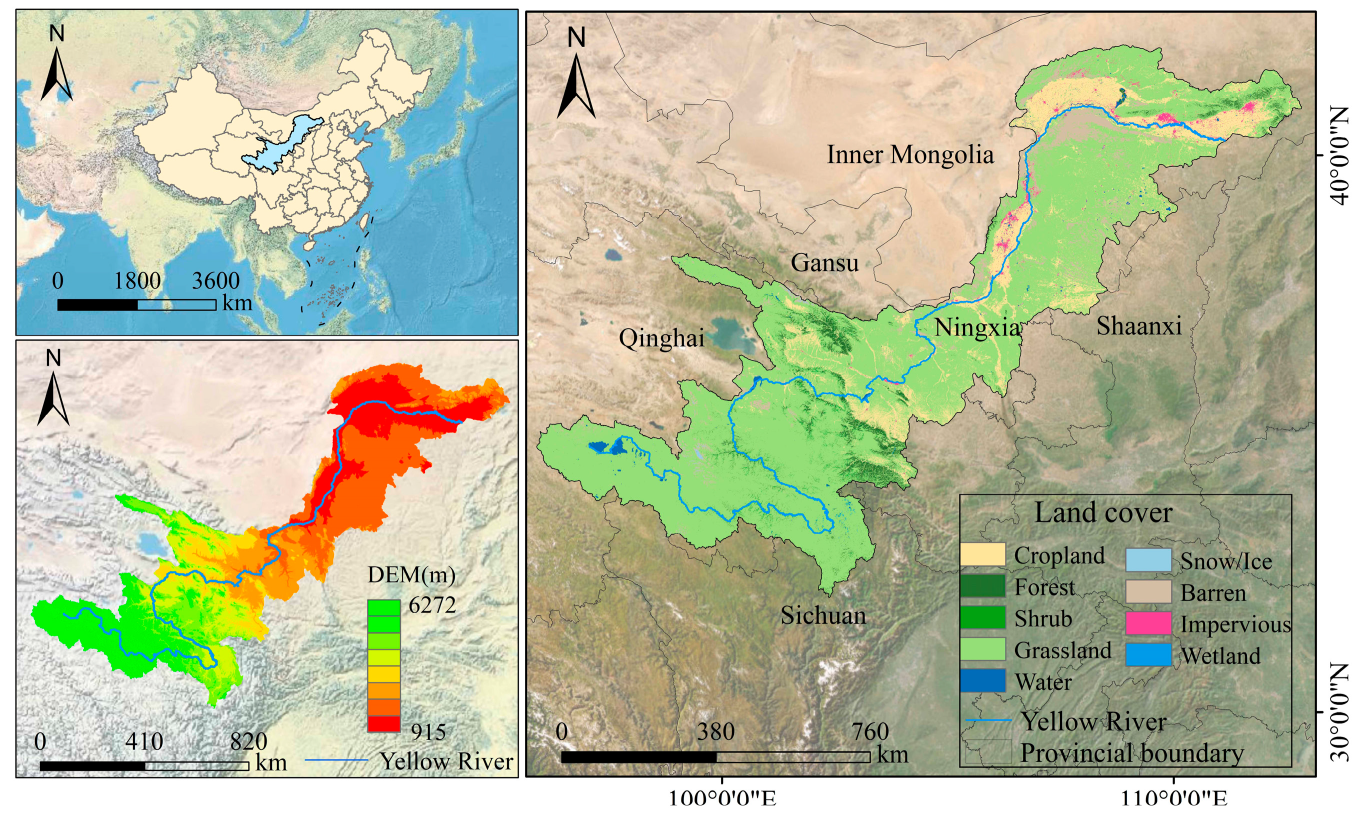
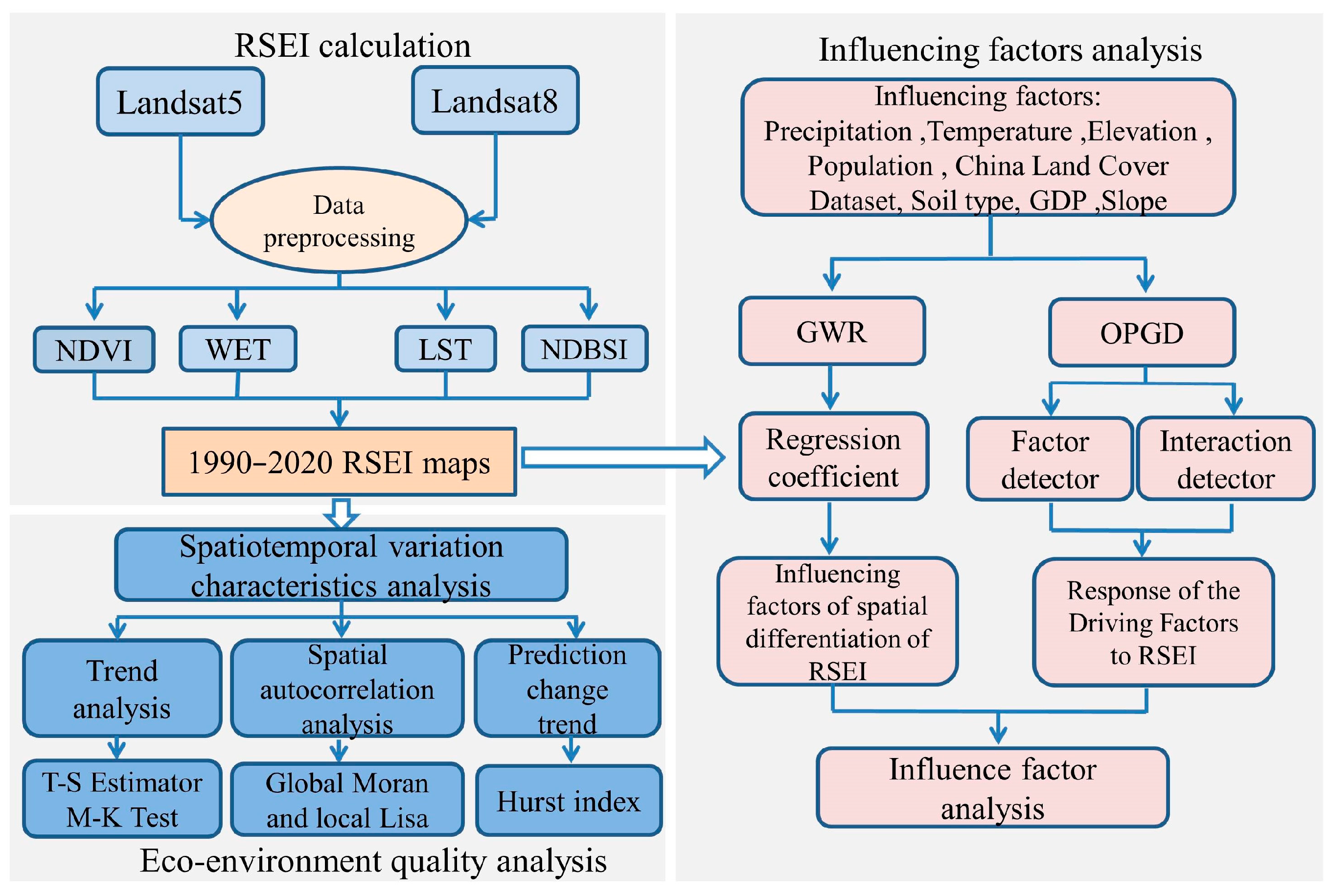
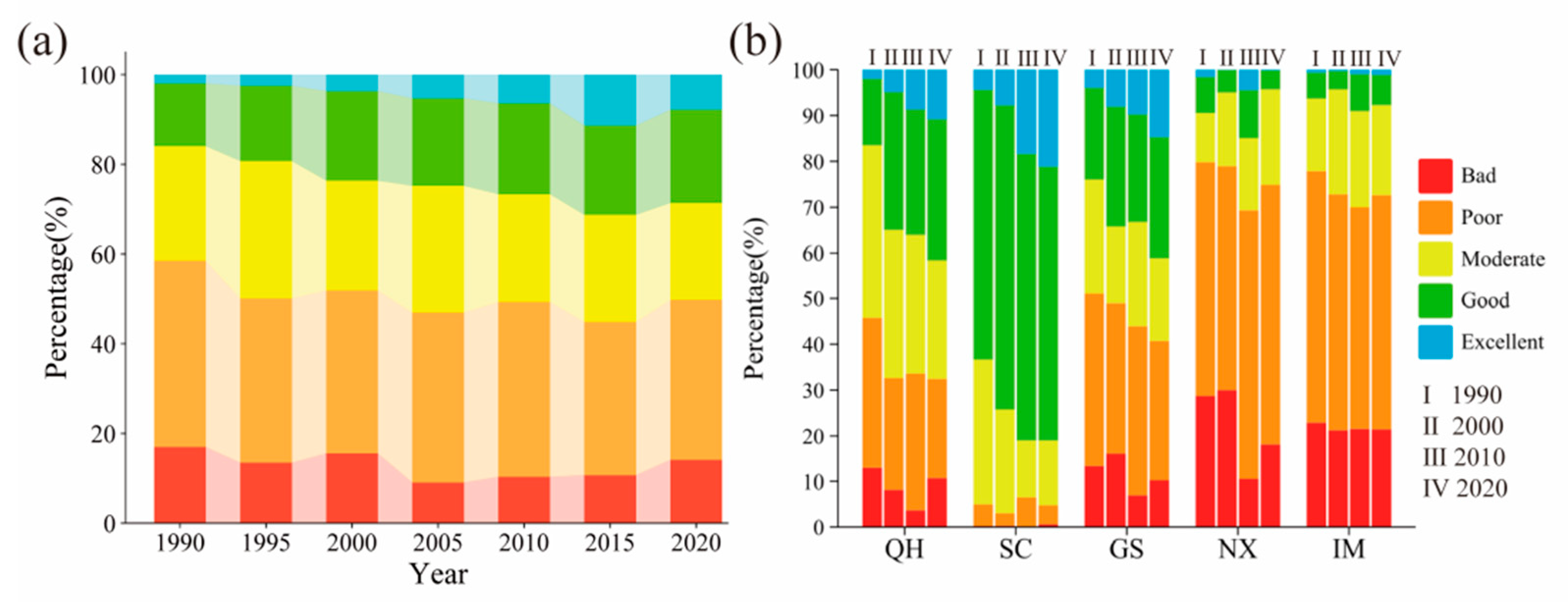


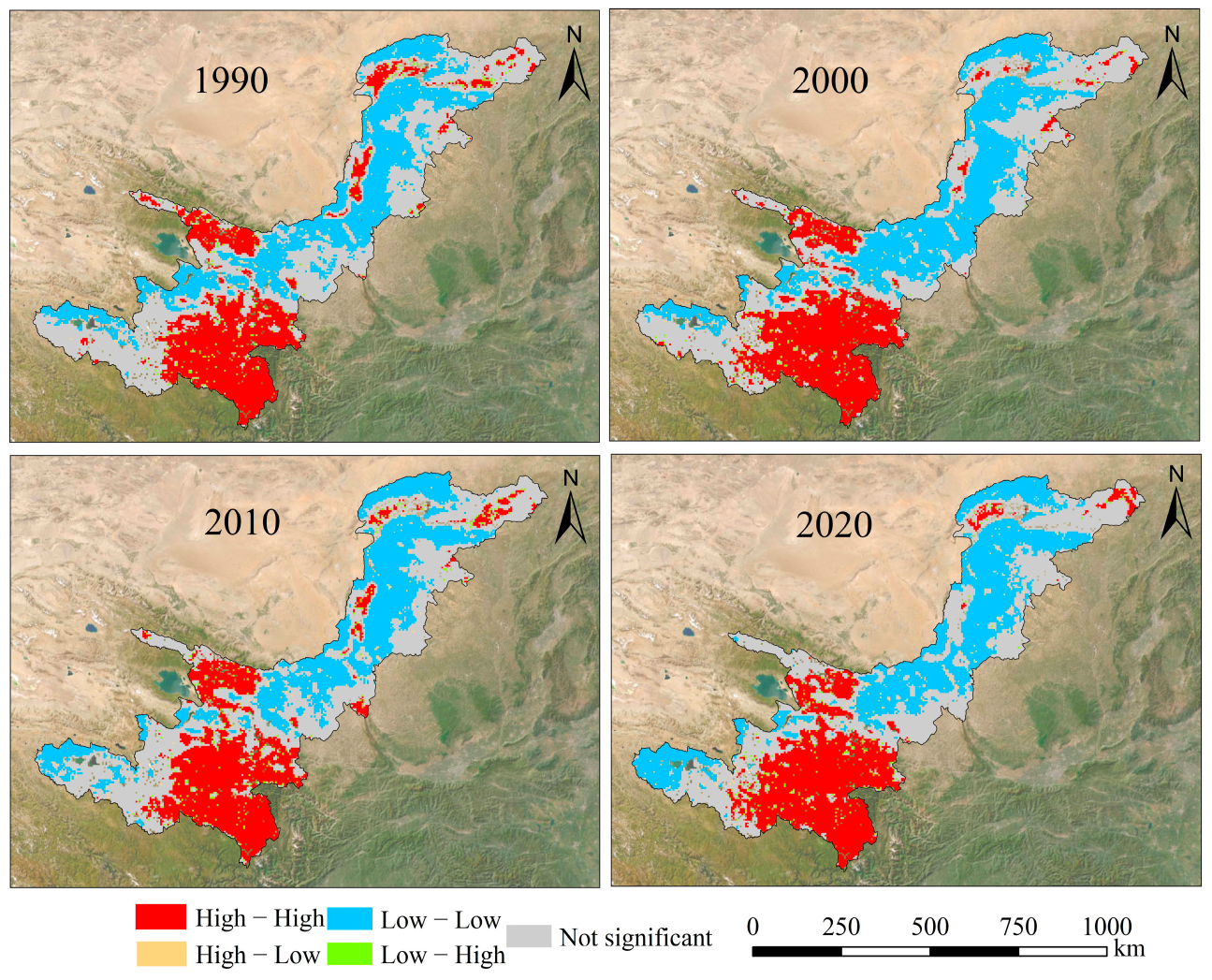

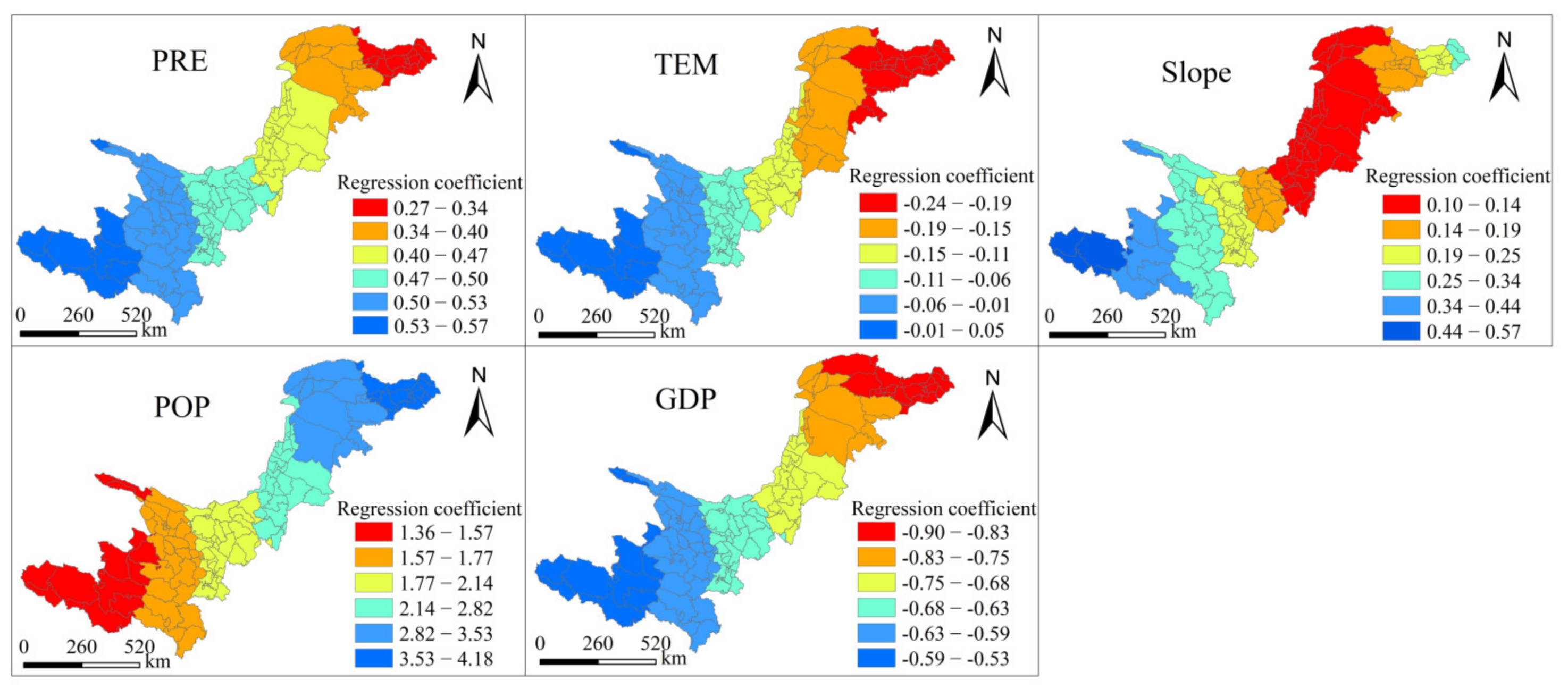

| Data Types | Resolution | Source |
|---|---|---|
| TEM | 1 km | http://www.geodata.cn/main/#/ (accessed 20 June 2024) |
| PRE | 1 km | http://www.geodata.cn/main/#/ (accessed 20 June 2024) |
| DEM | 30 m | https://www.resdc.cn |
| Slope | 1 km | https://www.resdc.cn |
| Soil type | 1 km | https://www.resdc.cn |
| GDP | 1 km | https://www.resdc.cn |
| POP | 1 km | https://www.resdc.cn |
| CLCD | 30 m | https://zenodo.org/records/12779975 (accessed 10 July 2024) |
| Index | Formula |
|---|---|
| NDVI | |
| WET | |
| NDBSI | |
| LST |
| Slope | Hurst | Type | Shorthand | Description |
|---|---|---|---|---|
| <0 | >0.5 | Down–Down | DD | Down continuously |
| <0 | <0.5 | Down–Up | DU | First down then up |
| 0 | =0.5 | Random | RD | No regularity |
| >0 | <0.5 | Up–Down | UD | First up then down |
| >0 | >0.5 | Up–Up | UU | Up continuously |
Disclaimer/Publisher’s Note: The statements, opinions and data contained in all publications are solely those of the individual author(s) and contributor(s) and not of MDPI and/or the editor(s). MDPI and/or the editor(s) disclaim responsibility for any injury to people or property resulting from any ideas, methods, instructions or products referred to in the content. |
© 2025 by the authors. Licensee MDPI, Basel, Switzerland. This article is an open access article distributed under the terms and conditions of the Creative Commons Attribution (CC BY) license (https://creativecommons.org/licenses/by/4.0/).
Share and Cite
Tang, X.; Zhou, T.; Huang, C.; Feng, T.; Bie, Q. Analysis of Ecological Environment Changes and Influencing Factors in the Upper Reaches of the Yellow River Based on the Remote Sensing Ecological Index. Sustainability 2025, 17, 5410. https://doi.org/10.3390/su17125410
Tang X, Zhou T, Huang C, Feng T, Bie Q. Analysis of Ecological Environment Changes and Influencing Factors in the Upper Reaches of the Yellow River Based on the Remote Sensing Ecological Index. Sustainability. 2025; 17(12):5410. https://doi.org/10.3390/su17125410
Chicago/Turabian StyleTang, Xianghua, Ting Zhou, Chunlin Huang, Tianwen Feng, and Qiang Bie. 2025. "Analysis of Ecological Environment Changes and Influencing Factors in the Upper Reaches of the Yellow River Based on the Remote Sensing Ecological Index" Sustainability 17, no. 12: 5410. https://doi.org/10.3390/su17125410
APA StyleTang, X., Zhou, T., Huang, C., Feng, T., & Bie, Q. (2025). Analysis of Ecological Environment Changes and Influencing Factors in the Upper Reaches of the Yellow River Based on the Remote Sensing Ecological Index. Sustainability, 17(12), 5410. https://doi.org/10.3390/su17125410







